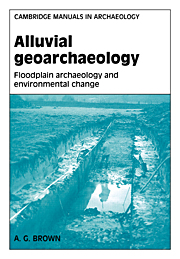Book contents
- Frontmatter
- Contents
- List of illustrations
- List of tables
- Preface
- Acknowledgements
- Introduction and the example of the Nile
- PART I PRINCIPLES
- PART II APPLICATION
- 5 Artifacts from floodplains and rivers
- 6 The rise and fall of forested floodplains in North-West Europe
- 7 Buried sites
- 8 Managed floodplains
- 9 The cultural archaeology of floodplains
- 10 People, floodplains and environmental change
- APPENDICES
- References
- Subject Index
- Index of rivers and sites
10 - People, floodplains and environmental change
Published online by Cambridge University Press: 03 December 2009
- Frontmatter
- Contents
- List of illustrations
- List of tables
- Preface
- Acknowledgements
- Introduction and the example of the Nile
- PART I PRINCIPLES
- PART II APPLICATION
- 5 Artifacts from floodplains and rivers
- 6 The rise and fall of forested floodplains in North-West Europe
- 7 Buried sites
- 8 Managed floodplains
- 9 The cultural archaeology of floodplains
- 10 People, floodplains and environmental change
- APPENDICES
- References
- Subject Index
- Index of rivers and sites
Summary
This final chapter further develops the theme of human–environment interactions in alluvial contexts. It aims to show how environmental change at a variety of temporal scales and human response can be viewed not as being deterministic, but, owing to sociocultural factors, as semi-predictable if enough is known about human perceptions of environmental change and the socioeconomic structure of society. A simplistic neo-classical model is used as the springboard for exploring the many social, cultural and political factors which cause this to be so. It is argued that at the root of past simplistic views of human–environment interactions has been a deep-seated conceptualised dichotomy between humans and environment most poignantly illustrated in the false dichotomy of the ‘human versus climate’ debate over the causes of alluviation.
Palaeohydrology, climate and resources
In 1967, Sir Mortimer Wheeler commented caustically on the ‘established belief in recurrent changes of climate, the imprecise usage of the term such as “wetter”, “drier”, “warmer”, “more genial”: “wetter” etc. than what?’ (Wheeler in Raikes, 1967). In chapters 3, 4 and 8 various methods of reconstructing past river flow and climate were introduced. The reasoning employed in palaeohydrology is typical of that used in the interpretation of environment–climate interactions (Figure 10.1). Deductive reasoning is used to determine level 2 information. Implications for levels 3, 4 and 5 are considerably more speculative.
- Type
- Chapter
- Information
- Alluvial GeoarchaeologyFloodplain Archaeology and Environmental Change, pp. 304 - 316Publisher: Cambridge University PressPrint publication year: 1997



